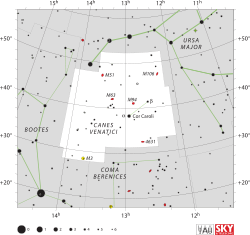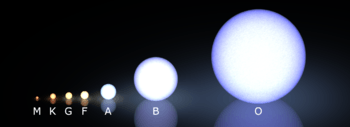Beta Canum Venaticorum

| |
| Observation data Epoch J2000 Equinox J2000 | |
|---|---|
| Constellation | Canes Venatici |
| Right ascension | 12h 33m 44.54482s[1] |
| Declination | +41° 21′ 26.9248″[1] |
| Apparent magnitude (V) | 4.26[2] |
| Characteristics | |
| Spectral type | G0 V[2] |
| U−B color index | 0.04[3] |
| B−V color index | 0.58[3] |
| Astrometry | |
| Radial velocity (Rv) | +6.9[4] km/s |
| Proper motion (μ) | RA: –704.75[1] mas/yr Dec.: +292.74[1] mas/yr |
| Parallax (π) | 118.49 ± 0.20[1] mas |
| Distance | 27.53 ± 0.05 ly (8.44 ± 0.01 pc) |
| Absolute magnitude (MV) | 4.64[5] |
| Details | |
| Mass | 1.025 ± 0.050[6] M☉ |
| Radius | 1.123 ± 0.028[7] R☉ |
| Luminosity | 1.151 ± 0.018[7] L☉ |
| Surface gravity (log g) | 4.60[8] cgs |
| Temperature | 5,653 ± 72[7] K |
| Metallicity [Fe/H] | –0.21[8] dex |
| Rotational velocity (v sin i) | 2.9 ± 0.4[9] km/s |
| Age | 5.3[10] to 7.1[5] Gyr |
| Other designations | |
| Database references | |
| SIMBAD | data |
| ARICNS | data |
Beta Canum Venaticorum (β Canum Venaticorum, abbreviated Beta CVn, β CVn), also named Chara,[11] is a G-type main-sequence star in the northern constellation of Canes Venatici. At an apparent visual magnitude of 4.26,[2] it is the second-brightest star in this relatively faint constellation. Based upon an annual parallax shift of 118.49 mas,[1] this star is 27.53 light-years (8.44 parsecs) distant from the Sun.
Along with the brighter star Cor Caroli, the pair form the "southern dog" in this constellation that represents hunting dogs.
Nomenclature
β Canum Venaticorum (Latinised to Beta Canum Venaticorum) is the star's Bayer designation.
The traditional name Chara was originally applied to the "southern dog", but it later became used specifically to refer to Beta Canum Venaticorum. Chara (χαρά) means 'joy' in Greek.[12] In 2016, the International Astronomical Union organized a Working Group on Star Names (WGSN)[13] to catalog and standardize proper names for stars. The WGSN's first bulletin of July 2016[14] included a table of the first two batches of names approved by the WGSN; which included Chara for this star.
In Chinese, 常陳 (Cháng Chén), meaning Imperial Guards, refers to an asterism consisting of Beta Canum Venaticorum, Alpha Canum Venaticorum, 10 Canum Venaticorum, 6 Canum Venaticorum, 2 Canum Venaticorum, and 67 Ursae Majoris.[15] Consequently, Beta Canum Venaticorum itself is known as 常陳四 (Cháng Chén sì, English: the Fourth Star of Imperial Guards.)[16]
Observations
Beta CVn has a stellar classification of G0 V, and so is a G-type main sequence star. Since 1943, the spectrum of this star has served as one of the stable anchor points by which other stars are classified.[17] The spectrum of this star shows a very weak emission line of singly ionized calcium (Ca II) from the chromosphere, making it a useful reference star for a reference spectrum to compare with other stars in a similar spectral category.[18] (The Ca-II emission lines are readily accessible and can be used to measure the level of activity in a star's chromosphere.)
Beta CVn is considered to be slightly metal-poor,[8] which means it has a somewhat lower portion of elements heavier than helium when compared to the Sun. In terms of mass, age and evolutionary status, however, this star is very similar to the Sun.[19] As a result, it has been called a solar analog. It is about 3% more massive than the Sun,[6] with a radius 12% larger than the Sun's and 15% greater luminosity.[7]
The components of this star's space velocity are (U, V, W) = (–25, 0, +2) km/s.[19] In the past it was suggested that it may be a spectroscopic binary. However, further analysis of the data does not seem to bear that out.[20] In addition, a 2005 search for a brown dwarf in orbit around this star failed to discover any such companion, at least down to the sensitivity limit of the instrument used.[21]
Possibility of life

In 2006, astronomer Margaret Turnbull labeled Beta CVn as the top stellar system candidate to search for extraterrestrial life forms.[22] Because of its solar-type properties, astrobiologists have listed it among the most astrobiologically interesting stars within 10 parsecs of the Sun.[19] However, as of 2009, this star is not known to host planets.[6]
This chart compares the sun to Beta Canum Venaticorum.
| Identifier | J2000 Coordinates | Distance (ly) |
Stellar Class |
Temperature (K) |
Metallicity (dex) |
Age (Gyr) |
Notes | |
|---|---|---|---|---|---|---|---|---|
| Right ascension | Declination | |||||||
| Sun | — | — | 0.00 | G2V | 5,778 | +0.00 | 4.6 | [23] |
| Beta Canum Venaticorum [24] | 12h 33m 44.54s | +41° 21′ 26.92″ | 27.53 | G0 V | 5,653 | –0.21 | 5.9 | |
To date no solar twin with an exact match as that of the Sun has been found, however, there are some stars that come very close to being identical to that of the Sun, and are such considered solar twins by the majority of the public. An exact solar twin would be a G2V star with a 5,778K temperature, be 4.6 billion years old, with the correct metallicity and a 0.1% solar luminosity variation.[25] Stars with an age of 4.6 billion years are at the most stable state. Proper metallicity and size are also very important to low luminosity variation. [26][27][28]
See also
References
- 1 2 3 4 5 6 van Leeuwen, F. (November 2007), "Validation of the new Hipparcos reduction", Astronomy and Astrophysics, 474 (2): 653–664, arXiv:0708.1752
 , Bibcode:2007A&A...474..653V, doi:10.1051/0004-6361:20078357.
, Bibcode:2007A&A...474..653V, doi:10.1051/0004-6361:20078357. - 1 2 3 4 "bet CVn -- Spectroscopic binary". SIMBAD. Centre de Données astronomiques de Strasbourg. Retrieved 2010-07-04.
- 1 2 Argue, A. N. (1966). "UBV photometry of 550 F, G and K type stars". Monthly Notices of the Royal Astronomical Society. 133: 475–493. Bibcode:1966MNRAS.133..475A. doi:10.1093/mnras/133.4.475.
- ↑ Wilson, Ralph Elmer (1953). General Catalogue of Stellar Radial Velocities. Washington: Carnegie Institution of Washington. Bibcode:1953GCRV..C......0W.
- 1 2 Holmberg, J.; Nordström, B.; Andersen, J. (July 2009), "The Geneva-Copenhagen survey of the solar neighbourhood. III. Improved distances, ages, and kinematics", Astronomy and Astrophysics, 501 (3): 941–947, arXiv:0811.3982
 , Bibcode:2009A&A...501..941H, doi:10.1051/0004-6361/200811191.
, Bibcode:2009A&A...501..941H, doi:10.1051/0004-6361/200811191. - 1 2 3 van Belle, Gerard T.; von Braun, Kaspar (April 2009). "Directly Determined Linear Radii and Effective Temperatures of Exoplanet Host Stars". The Astrophysical Journal. 694 (2): 1085–1098. arXiv:0901.1206
 . Bibcode:2009ApJ...694.1085V. doi:10.1088/0004-637X/694/2/1085.
. Bibcode:2009ApJ...694.1085V. doi:10.1088/0004-637X/694/2/1085. - 1 2 3 4 Boyajian, Tabetha S.; et al. (February 2012), "Stellar Diameters and Temperatures. I. Main-sequence A, F, and G Stars", The Astrophysical Journal, 746 (1): 101, arXiv:1112.3316
 , Bibcode:2012ApJ...746..101B, doi:10.1088/0004-637X/746/1/101.. See Table 10.
, Bibcode:2012ApJ...746..101B, doi:10.1088/0004-637X/746/1/101.. See Table 10. - 1 2 3 Luck, R. Earle; Heiter, Ulrike (2006). "Dwarfs in the Local Region". The Astronomical Journal. 131 (2): 3069–3092. Bibcode:2006AJ....131.3069L. doi:10.1086/504080.
- ↑ Herrero, E.; et al. (January 2012), "Optimizing exoplanet transit searches around low-mass stars with inclination constraints", Astronomy & Astrophysics, 537: A147, arXiv:1110.5840
 , Bibcode:2012A&A...537A.147H, doi:10.1051/0004-6361/201117809.
, Bibcode:2012A&A...537A.147H, doi:10.1051/0004-6361/201117809. - ↑ Barry, Don C.; Cromwell, Richard H.; Hege, E. Keith (1987). "Chromospheric activity and ages of solar-type stars". Astrophysical Journal, Part 1. 315: 264–272. Bibcode:1987ApJ...315..264B. doi:10.1086/165131.
- ↑ "IAU Catalog of Star Names". Retrieved 28 July 2016.
- ↑ Kaler, Jim. "Beta Canum Venaticorum". Stars. University of Illinois. Retrieved 2006-12-06.
- ↑ "IAU Working Group on Star Names (WGSN)". Retrieved 22 May 2016.
- ↑ "Bulletin of the IAU Working Group on Star Names, No. 1" (PDF). Retrieved 28 July 2016.
- ↑ (Chinese) 中國星座神話, written by 陳久金. Published by 台灣書房出版有限公司, 2005, ISBN 978-986-7332-25-7.
- ↑ (Chinese) 香港太空館 - 研究資源 - 亮星中英對照表, Hong Kong Space Museum. Accessed on line November 23, 2010.
- ↑ Garrison, R. F. (December 1993), "Anchor Points for the MK System of Spectral Classification", Bulletin of the American Astronomical Society, 25: 1319, Bibcode:1993AAS...183.1710G, retrieved 2012-02-04.
- ↑ Herbig, G. H. (1985). "Chromospheric H-alpha emission in F8-G3 dwarfs, and its connection with the T Tauri stars". Astrophysical Journal. 289 (1): 269–278. Bibcode:1985ApJ...289..269H. doi:10.1086/162887.
- 1 2 3 de Mello, G. P.; del Peloso, E. F.; Ghezzi, L. (2006). "Astrobiologically Interesting Stars Within 10 Parsecs of the Sun" (PDF). Astrobiology (abstract). 6 (2): 308–331. arXiv:astro-ph/0511180
 . Bibcode:2006AsBio...6..308P. doi:10.1089/ast.2006.6.308. PMID 16689649. Retrieved 2008-05-05.
. Bibcode:2006AsBio...6..308P. doi:10.1089/ast.2006.6.308. PMID 16689649. Retrieved 2008-05-05. - ↑ Morbey, C. L.; Griffin, R. F. (1987). "On the reality of certain spectroscopic orbits". Astrophysical Journal, Part 1. 317: 343–352. Bibcode:1987ApJ...317..343M. doi:10.1086/165281.
- ↑ Carson, J. C.; et al. (2006). "The Cornell High-Order Adaptive Optics Survey for Brown Dwarfs in Stellar Systems. I. Observations, Data Reduction, and Detection Analyses". The Astronomical Journal. 130 (3): 1212–1220. arXiv:astro-ph/0506287
 . Bibcode:2005AJ....130.1212C. doi:10.1086/432604.
. Bibcode:2005AJ....130.1212C. doi:10.1086/432604. - ↑ "Stars searched for extraterrestrials". PhysOrg.com. 2006-02-19. Retrieved 2008-05-04.
- ↑ Williams, D.R. (2004). "Sun Fact Sheet". NASA. Retrieved 2009-06-23.
- ↑ Beta Canum Venaticorum at SIMBAD - Ids - Bibliography - Image.
- ↑ NASA, Science News, Solar Variability and Terrestrial Climate, Jan. 8, 2013
- ↑ University of Nebraska-Lincoln astronomy education group, Stellar Luminosity Calculator
- ↑ National Center for Atmospheric Research, The Effects of Solar Variability on Earth's Climate, 2012 Report
- ↑ Most of Earth’s twins aren’t identical, or even close!, by Ethan on June 5, 2013
External links
- "Chara". SolStation. Retrieved 2006-12-06.
- "Astronomer announces shortlist of stellar candidates for habitable worlds". SpaceRef.com. 2006-02-18. Retrieved 2006-08-10.